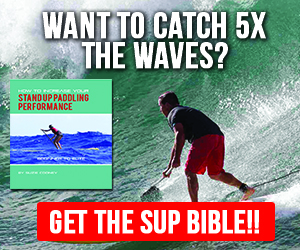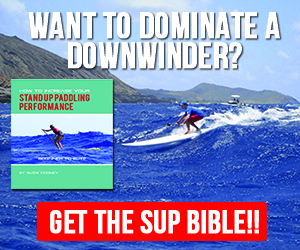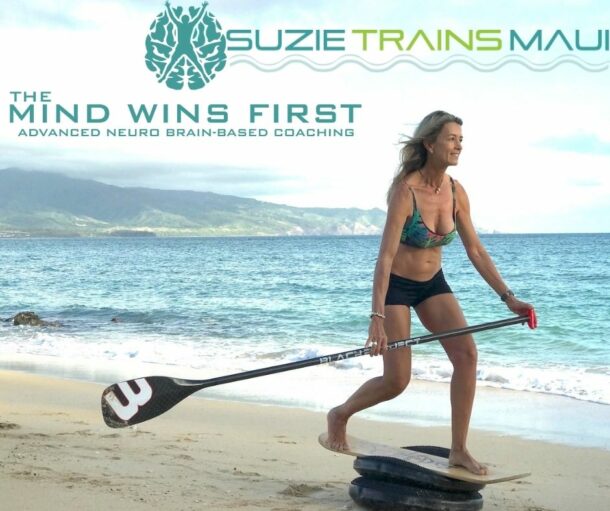Surfing to Stay Fit, Lose Weight and What Beginners Should Know. Also, Which Muscle Groups are Affected and How to Stay Safe on the Waves
Suzie Cooney, CPT Suzie Trains Maui
![]()
Surfing is amazing sport that requires endurance, upper and lower body strength and also good flexibility. What’s great about surfing, is that it’s really a total body sport and get’s you toned and in shape. Most surfers I know are in amazing shape from head to toe!
You can burn a great deal of calories while surfing. Even as a beginner you will challenge muscles you may have not even knew you had! As you are “pulling” your arms through the water as you paddle, that additional resistance is really a workout. Since you are also in the “prone” or face down position, while you are paddling, this places a little more stress on your heart, therefore an opportunity to perform a little cardio.
So most definitely if you are embarking on a weight loss program, surfing can do wonders for the entire body. I encourage all my clients to give it a try to mix up their routine and keep things fresh. They are all so amazed on how strong and lean they can get fast. You don’t see too many out of shape surfers!
Surfing vs. other sports (surfing benefits in staying fit and losing weight)
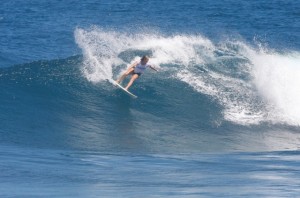
Our Paige Alms ripp'n at Hookipa Photo by Simone Reddingius
Surfing has so many wonderful health benefits to keep you fit and keep the weight off. Besides being super fun and probably the most challenging sport you’ll ever try, the long-term results are your reward. You have to realize that water is constantly moving in all directions, say vs. a tennis court. Tennis of course is a great sport that definitely gets you in shape, but it doesn’t require the same extra challenges. Surfing requires you to have good balance, fast reactions, and to recruit so many more muscles. It is an explosive movement to hop to your feet and then stabilize and react to the wave or other surfers that may be near you. Also, as mentioned earlier, surfing requires total body endurance which equals more calories burned!
Muscles We Use to Surf
The main muscles that are used are the upper back, lats, shoulders, lower back, neck and legs. Your core muscles, (rectus abdominis, erector spinae, multifidus, internal/external obliques, transverse abdominis, hip flexors) is where all movement begins; must work in unison to keep you stable and steady as you paddle. Your triceps and chest muscles are the ones that will help you push up quickly to your feet. Your upper back and neck muscles assist in keeping your chest up off the nose of the board, so you can be more efficient as you paddle. The low back muscles work hard to support your entire upper body as you paddle. Finally, your legs are the power house that get’s you up to your feet fast and helps you carve your turns or hang ten on the nose!
Exercises and stretches to do before surfing and in the gym.
There are many great exercises and stretches a beginner surfer should learn, that will make surfing way more fun and allow you to last longer on the water. Although there are many theories as to when and how one should stretch, I recommend that before you hit the water one should perform “active” stretches that actually mimic surfing. Active stretching is different than static stretching or holding a stretch for more than 30 seconds. When you are not on the water and are training for your surf sessions, specific surf conditioning exercises are very critical to help build better endurance and strength.
An example of an active stretch would simply be standing on the beach; feet shoulder width apart, and moving your arms independently in large forward and backward circles. A count of 10-15 reps each side is good. Also, head rolls for your neck. Same position, shoulders loose, tilt head down, slowly roll up to the right and then left. A few times each side. Also, quick leg squats to help you to your feet faster and warm up the hips and legs. Stand with feet a little wider than shoulder width apart, toes pointed at 10 and 2 o’clock, grasp hands together in front and at a pace that’s a little fast, squat down then drive up through the heels, down then up. About 10-15 reps is great. You can also throw in some side and forward bends. Lastly, quick shoulder shrugs up and down, then wax and go!
Exercises in the gym or at home could include, lat pull downs, lots of push – ups ( knee bent is fine ), burpees, leg squats and lunges, tricep pull downs, low back exercises and a great deal of core work. For surf conditioning, remember it’s about total body endurance, not lifting a huge amount of weight, but increasing your reps.
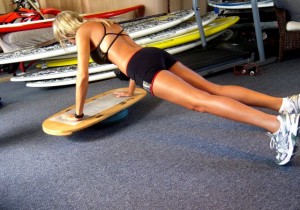
IndoBoard Push Up on Disc
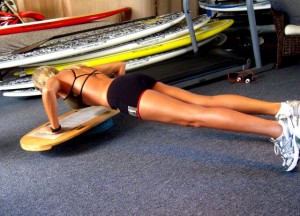
Indo Board Push Up on Disc
Check out a few of my beginner and advanced exercises at www.suzietrainsmaui.com/blog. You’ll notice most surfers are lean and don’t have a huge amount of bulk. I’ve trained really big athletes who are professionals and they can’t move as easily, nor are they as quick to their feet. But don’t let that discourage you.
Balance training is also critical to ensure your pop ups are smooth and stable. I have all kinds of training toys that mimic surfing. My favorite is the Indo Board. 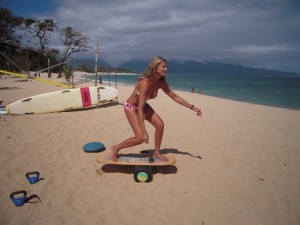 It’s like training your brain and all the finite muscles that help stabilize the larger muscles of the hips and legs. You can practice standing on one leg and then moving that leg in all planes; front, side and back. To make more challenging, hold an 8lb medicine ball or dumb bell with arms extended in front of you. You can also try and kneel on a stability ball. I love this.. Not only are you helping your balance, you are training your core too. This is an advanced move, to if you would like to attempt this exercise; you may want to hold onto to a sturdy object.
It’s like training your brain and all the finite muscles that help stabilize the larger muscles of the hips and legs. You can practice standing on one leg and then moving that leg in all planes; front, side and back. To make more challenging, hold an 8lb medicine ball or dumb bell with arms extended in front of you. You can also try and kneel on a stability ball. I love this.. Not only are you helping your balance, you are training your core too. This is an advanced move, to if you would like to attempt this exercise; you may want to hold onto to a sturdy object.
Examples of good surf specific exercises are tricep dips, tricep kickbacks and tricep presses as suggested earlier. In addition, shoulder and lat pull downs, shoulder presses with lighter weights, variations of chest presses or pushups, single leg squats, and burpees ( dropping down into the push up position, then quickly jumping to your feet, then jump in the air ). Or simply, practice your pop ups by lying on the ground like you are paddling. Looking ahead to where you want to go, then in one fell swoop, up to your feet! Do about 10 of these and you’ll be getting your heart rate up!
Is surfing for everybody? Are there medical conditions that affect surfing that beginner surfer should know about?
Living on Maui, surfing is just something you grow up doing or canoe paddling or something water related. The warm water helps too! I learned in Northern California, in a town called Bolinas, where the great whites played, but it didn’t stop me! Surfing is a sport and a lifestyle that is embraced by all ages, ethnicities and is always different every time you venture into the waves. If one is not comfortable in the water, it may take some extra courage. But the people that I have taught who had severe water phobias soon forgot about what may be lurking in the water and had so much fun from the thrill of gliding down a small mountain of water, nothing else mattered.
As for people having certain medical conditions, like any other new activity or sport, one may want to consult their physician. Surfing is rigorous and for people with low back or neck issues might take some pre caution. For some, it can be a huge benefit and aid in strengthening over or underactive muscles. Expect to be a little sore in the arms and shoulders, but you won’t care because your smile from your first ride and that feeling will be the only thing you’ll remember!
Staying Safe and Knowing the Rules of the Waves
Surf Rules
Surfing tends to be pretty free from rules and restrictions but there are certain accepted rules, mostly based on safety and common sense.
1. Wave ownership (The My Wave Rule):
The person closest to the breaking part of the wave has the right of way.
2. Caveat:
If someone is up and riding, paddling into the wave behind them does not give you the wave. Also note: In many low-key breaks, the first person paddling for the wave owns it. Do not expect this to apply in crowded conditions.
3. Dropping In (The Thou Shalt Not Rule):
Dropping in is taking off on a wave in front of someone who is already up and riding. Don’t do this. Ever. No Exceptions.
4. Paddling Out (The Eat it Rule):
When paddling out, if you must get over a wave that someone is riding, paddle behind them (on the white water side). This generally means getting stuffed for the sake of someone else’s ride. Take comfort in the hope that they would do the same for you. Do not paddle in front of someone unless you are so sure that you will be 20 feet + in front of them that you willing to be the well being of your board/car/nose on it.
5. Respect
Surfing has an unwritten code of respect. Don’t take all the waves. Let a few pass you by. If you are knew to a break or location, paddle in casually, smiling. Get a little eye contact so people know you know that you are there to have fun and you’re not there to get in their way. Also, sit on the shoulder and observe who in the water are the better surfers, and you may want to keep out of their line. The shoulder of the wave is often safest if you are learning and there are lots of people out.
Remember, surfing is all about fun and self-expression so don’t get too stressed if someone makes an honest mistake and drops in on you. Be mellow, life is too short.
See you on the water. Remember strong lats, and triceps = more rides! Suzie
Call me if I can help you get stronger so you can surf longer!
Suzie Cooney, CPT Suzie Trains Maui www.suzietrainsmaui.com/blog

